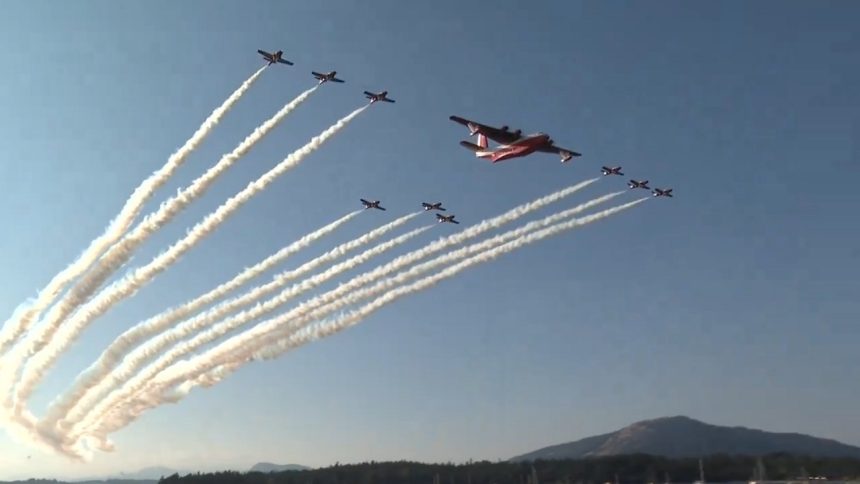One of the only two surviving Martin JRM Mars flying boats was finally retired after 78 years of service, flying to its new home at the British Columbia Aviation Museum.
“Hawaii Mars II”, one of the only two remaining Martin JRM Mars flying boats of World War II-fame, finally retired to a museum on Aug. 11, 2024, after well over 78 years of service. The aircraft has been used for years for firefighting missions in British Columbia, Canada, until 2015.
The final flight to the British Columbia Aviation Museum of Sidney, on Vancouver Island, included a spectacular fly-by of the flying boat, escorted by 9 CT-114 Tutors jet trainers of the Snowbirds, officially known as 431 Air Demonstration Squadron, the military aerobatics flight demonstration team of the Royal Canadian Air Force.
After landing in the bay, on Aug. 14, 2024, the Hawaii Mars will be slowly winched up a Coast Guard ramp for the de-watering process, before being moved to the museum between Aug. 19 and 23. There it will become a closed display while final preparations are carried on, until the official opening scheduled for Sep. 28, when visitors will be finally allowed to explore the inside the aircraft.
The Hawaii #MartinMars has made it to Greater Victoria! CHEK News video captured around 6:15 p.m. Sunday shows the moments the Hawaii water bomber flies over Patricia Bay in formation with the #Snowbirds. ✈️ @CHEK_News pic.twitter.com/Do1vQq8BJj
— Ethan Morneau (@EthanMorneau) August 12, 2024
Designed and built by the Martin Company, the precursor company who later merged first with American-Marietta to form Martin-Marietta and later with Lockheed to create the modern Lockheed Martin corporation, the JRM Mars was created in 1938 as a response to a United States Navy request for a long-range ocean patrol flying boat. The prototype was created by scaling up and adding two engines to the already large PBM Mariner patrol bomber, creating what would be the largest Allied flying boat of World War II.
The large four-engine flying boat was however delayed by development issues, and by 1942-43 its design was already considered obsolete, spurring the conversion into a cargo transport aircraft.
As the first airplane was delivered only in June 1945, the original order for 20 flying boats was scaled back with the end of the World War, reducing the production to just 7 airframes.
Last flight into the sunset. The Martin Mars has helped so many people during its life. ❤️ #MartinMars #aviation #airplane pic.twitter.com/47j0ZR5CJ9
— Foster Coulson (@FosterCoulson) August 12, 2024
Hawaii Mars
Hawaii Mars (actually Hawaii Mars II, as the original namesake sank in the Chesapeake Bay just a few days after delivery on Aug. 5, 1945 and was subsequently scrapped) was first delivered as the sixth Mars on Apr. 23, 1946, over 78 years ago, to the US Navy. Withdrawn from service in 1956 and sold in 1959, like its other three surviving stablemates, “Philippine Mars”, “Marianas Mars” and “Caroline Mars”, it was converted to forest fire fighting aircraft by adding water tanks in the cargo bay with retractable pick-up scoops.
The aircraft flew with registration C-FLYL first for FIFT (Forest Industries Flying Tankers), then FTI (Flying Tankers Inc.) and finally the Coulson Group. During its 55 years of firefighting missions, Hawaii Mars dropped over 50 million gallons of water on fires, which Coulson says is more than any other single firefighting aircraft in history anywhere in the world.

“Marianas Mars”, the fourth airframe, was lost in 1961 in a crash while serving as a firefighting plane, while the seventh and last aircraft, “Caroline Mars”, was damaged beyond repair during Typhoon Freda in 1962.
The last two remaining JRM Mars were acquired by the Coulson Group in 2007 and have been based at Sproat Lake, British Columbia.
“Philippine Mars”, the third Mars and now sporting the C-FLYK registration, has not flown to fight fires since 2007 and, after being repainted in its original U.S. Navy markings, is now awaiting transfer to be put in permanent display at the Pima Air and Space Museum in Arizona later in 2024.
Even if it underwent numerous upgrades, including a glass cockpit and accurate drop location systems, the fact that “Hawaii Mars” has not been used over fires since 2015 and the lack of perspective buyers, led it to share the fate of its stablemate, but actually preceding it in the delivery to the recipient museum.

Declining use of flying boats
The retirement of the last of the Mars aging giants, comes amid news of the retirement of the first ShinMaywa US-2 seaplane and further shrinks the number of large flying boats operational worldwide.
While the US-2 and the Chinese AG600 are still in production, they are available only in very limited numbers and so far failed to receive foreign orders.
A floatplane development of the Lockheed C-130 cargo plane, that has long been discussed, has apparently also been shelved recently.
Flying boats could be useful for operations in the Pacific Ocean, from special forces raids to missions in areas lacking proper infrastructure or only having austere locations, but the additional cost, impact on performance and more limited cargo and weapons capacity have so far limited flying boats operation to very niche use in little numbers.
Visualizza questo post su Instagram









